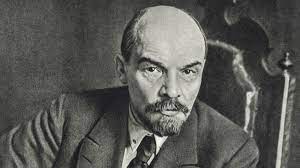8.3 The Russian Revolution and Its Effects
3 min read•june 18, 2024
Jillian Holbrook
AP European History 🇪🇺
335 resourcesSee Units
The Russian Revolution was a period of political and social revolution across the Russian Empire, commencing with the abolition of the monarchy in 1917 and concluding in 1923 with the Bolshevik establishment of the Soviet Union.
It began during World War I with the February Revolution, which focused in and around the then-Russian capital of Petrograd (now Saint Petersburg). In the chaos, members of the Duma, Russia's parliament, assumed control of the country and created the Russian Provisional Government. However, the Bolsheviks led by Vladimir Lenin believed the Provisional Government could not produce meaningful change. Consequently, they overthrew the government, instigating a dictatorship of the proletariat for socialist revolution by the working class and peasants in a regime based on Marxist–Leninist theory.

Vladimir Lenin; Image Courtesy of Wikimedia
Roots of the Bolshevik Revolution
Socialism emerged as a 19th-century response to the inequalities and exploitation caused by the Industrial Revolution. The Industrial Revolution led to the rapid growth of factories and cities and the concentration of wealth and power in the hands of a few industrialists. Workers faced poor working conditions, low wages, and long hours, while the owners of capital reaped the benefits of industrialization. Socialism, as a political and economic ideology, called for collective ownership and control of the means of production, distribution, and exchange, with the goal of ensuring fair distribution of wealth and benefits of economic growth to all members of society.
Russia was slow to industrialize after the abolition of serfdom, leaving many underemployed or unemployed completely. Moreover, with long-term issues of political stagnation and costly wars, including the Crimean War and then World War I, people began creating support for revolutionary change.
The Bolshevik Party was formed under the leadership of Vladimir Lenin, a Marxist who had been exiled for his political activities. Germany saw a possible Russian revolution as a way to take pressure off of the Eastern Front and focus the Russian military on internal dissent, weakening their ability to continue fighting in World War I for the Triple Entente. With funding and transportation from the German government, Lenin returned to Russia to organize the Bolsheviks for a revolution.
Russian Revolution
In 1915, Tsar Nicholas II left Petrograd to command the Russian forces against Germany after key losses. In his absence, the Russian people began protesting in the streets over government corruption and food shortages. (Nicholas was known for disbanding the Duma when they disagreed with his policies. His wife was firing elected officials in his absence.)
The February Revolution emerged as a mass protest movement in 1917 to respond to food shortages, high inflation, and widespread discontent with the government and ongoing war. Initially, women and workers led protests in the streets, but the demonstrations exploded into working strikes that caused Tsar Nicholas II to abdicate the throne.
Russian Civil War
A Provisional Government was established under the Duma after Tsar Nicholas II's abdication, but it was unable to restore order or end the war. In the October Revolution, Lenin and the Bolshevik Party overthrew the Provisional Government through military and worker insurrections. However, the takeover prompted a long civil war between communist forces and monarchists aided by foreign powers.
The Russian Civil War broke out in November 1917 between the Bolshevik's Red Army and the monarchist White Army, which sought liberal reform. Tsar Nicholas II and his family were removed from Petrograd for their “safety” and taken by Bolshevik forces out of the city, where they were murdered alongside their closest servants and staff, marking the end of the Romanov line.
After years of fighting and over 7 million deaths, mostly civilians, the war ended in 1923 with victory for the Red Army. The Bolsheviks took complete control of Russia and many states along the Russian border. Vladimir Lenin had authority over a newly formed union of communist states that became the Soviet Union.
In order to improve economic performance, Lenin compromised communist principles and employed some free-market principles under the New Economic Policy, which introduced market-oriented reforms and allowed for some private enterprise. The New Economic Policy was a departure from Lenin's original vision of socialism, but it helped the Soviet economy recover from the devastation of the Civil War and laid the foundation for later Soviet economic development.
Browse Study Guides By Unit
🎨Unit 1 – Renaissance & Exploration
⛪️Unit 2 – Reformation
👑Unit 3 – Absolutism & Constitutionalism
🤔Unit 4 – Scientific, Philosophical, & Political Developments
🥖Unit 5 – Conflict, Crisis, & Reaction in the Late 18th Century
🚂Unit 6 – Industrialization & Its Effects
✊Unit 7 – 19th Century Perspectives & Political Developments
💣Unit 8 – 20th Century Global Conflicts
🥶Unit 9 – Cold War & Contemporary Europe
📚Study Tools
🤔Exam Skills
👉Subject Guides

Fiveable
Resources
© 2025 Fiveable Inc. All rights reserved.